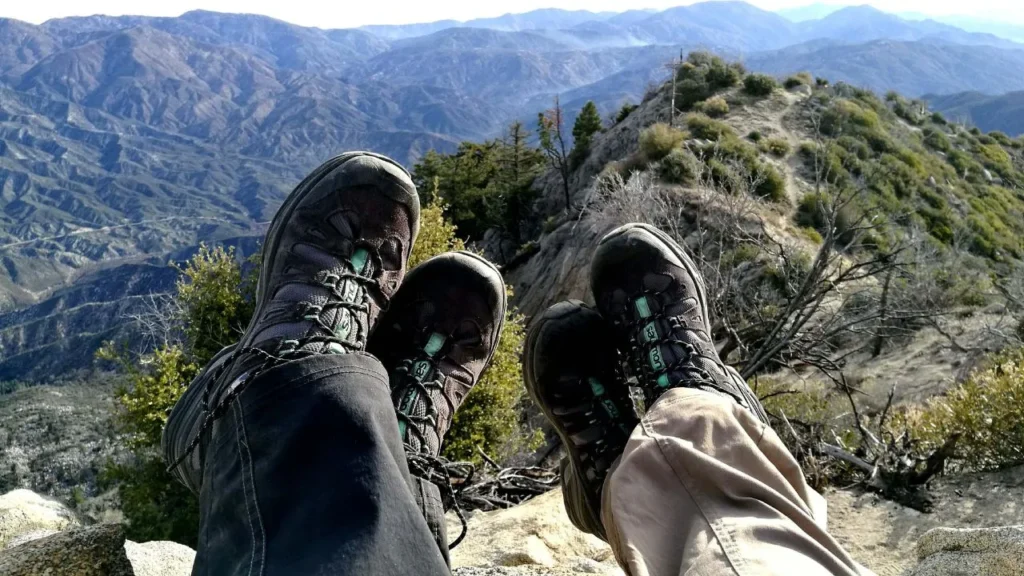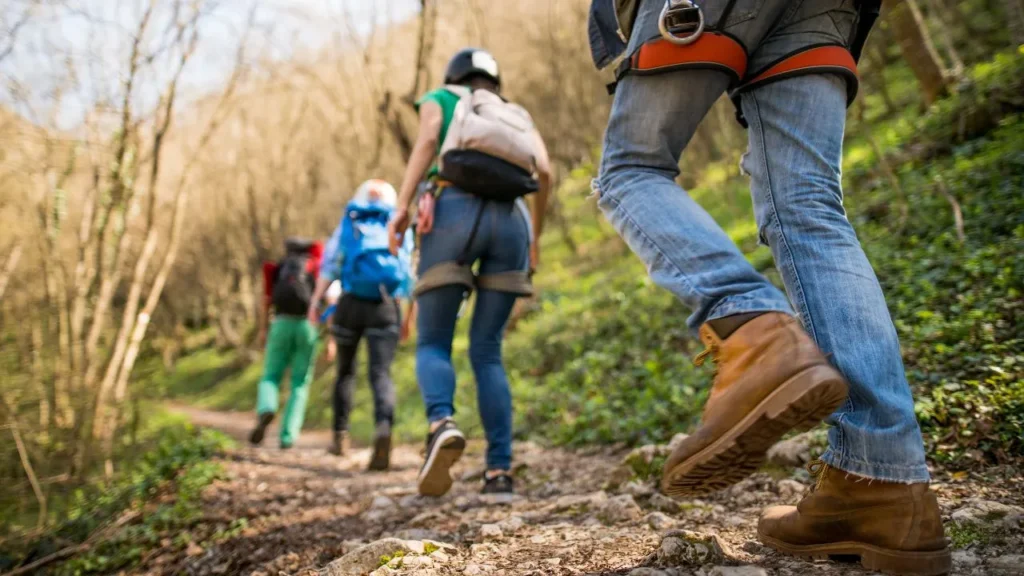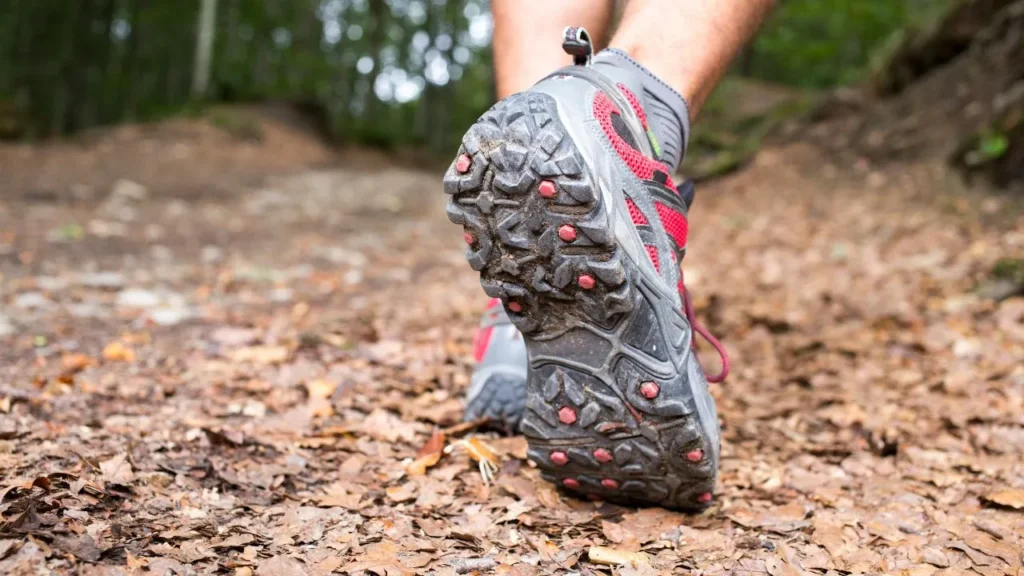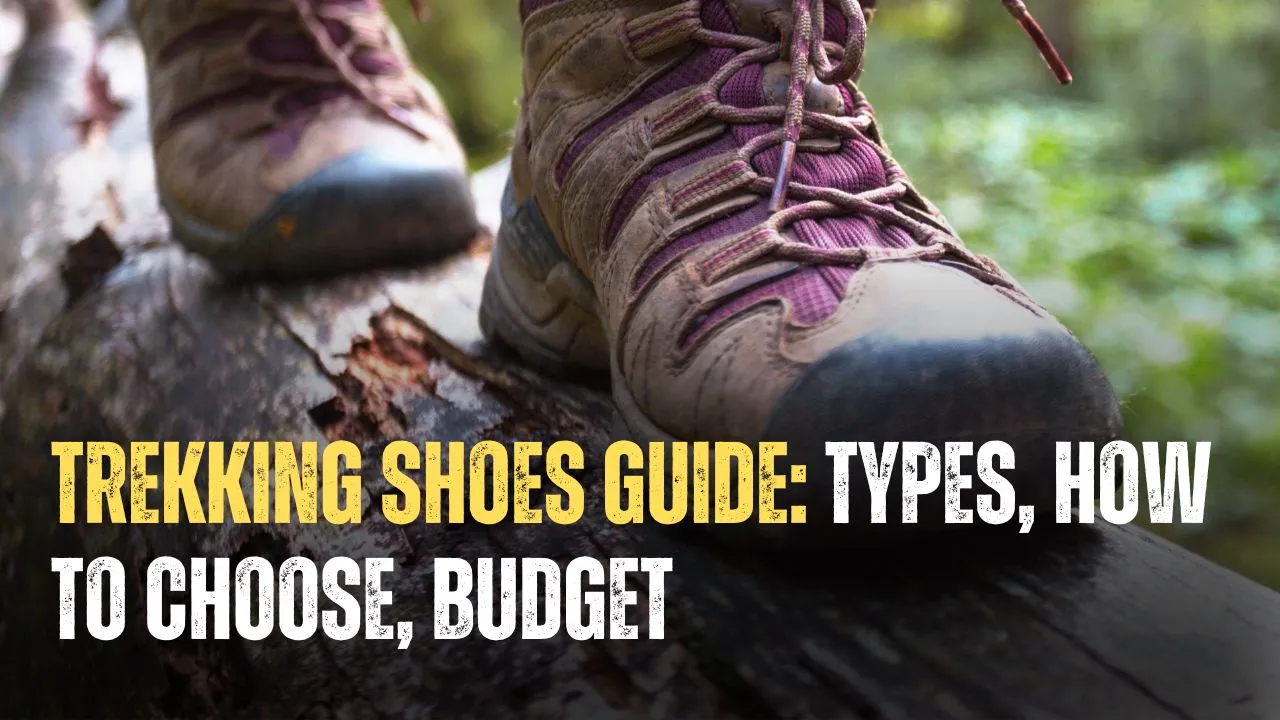Trekking shoes are the most important part of your trekking gear that can make or break your trekking experience. They make sure your feet feel safe, pain-free, comfortable, and supported with each step you take on the mighty peaks. While your willpower, physical strength, and training play a major role in successful trekking, a good pair of footwear gives you that extra push you need on difficult terrains.
Whether you are new to trekking or an experienced alpine climber, you need trekking footwear to keep your feet free from blisters, bruises, and muscle cramps. You must invest time and money in finding the pair that works for you with features like cushioning, water resistance, breathability, and more.
This comprehensive guide will help you understand the anatomy, types, and important tips to help you choose the best trekking shoes under your budget.

Table of Contents
Trekking Shoes vs Hiking Shoes: Understanding the difference
Most people mistake hiking shoes for trekking shoes but they are very different from each other in terms of functionality and build:
- Function: Hiking shoes are perfect for light usage, where your trekking activities are infrequent. On the other hand, if you are a frequent trekker who takes up bold adventures of hiking on challenging trails, trekking shoes will give you better protection and support. These shoes are best for winter or monsoon treks where you may encounter mossy, snowy, and muddy tracks that may cause a risk of slippage.
- Terrain: Hiking shoes are useful for well-maintained trails and provide good support for light climbing. While trekking shoes are suitable for long expeditions with rugged, uneven, and rocky trails.
- Pattern and build: Hiking shoes are lightweight, breathable, and have shallow grooves for easy hikes. Trekking shoes are water-resistant and have harder but flexible soles with deeper grooves and lug patterns for a strong grip in harsh terrains.

Anatomy and Key Components of Trekking Shoes
Before choosing the correct trekking shoes, it is important to understand their structure and anatomy. As a trekker, you should know the purpose of each part to make a calculated decision on what features you want in your desired pair. The anatomy of a trekking shoe includes:
Sole
Sole is the ‘soul’ of a trekking shoe. This part is in direct contact with the ground, giving you a strong grip and protecting you from discomfort. While trekking on difficult terrains, your life primarily depends on the good quality of grooves and lugs in the sole. It has three parts:
- Outer Sole
The outer part of the sole helps you maintain your climbing stance, increasing the friction in challenging, rocky, and moraine trails. Outer soles come in three types:
- All Terrain Traction (ATT) sole: As the name suggests, ATT soles are functional for all kinds of surfaces and are usually budget-friendly. They use materials like PU/nylon/rubber with hard and deep grooves and lugs to give traction and slush out the dirt.
- Vibram Sole: This sole is more flexible than ATT because it is made from vulcanized hard rubber. The special feature of its material is that it does not become stiff during winter and alpine treks. Trekking shoes with Vibram soles are more durable and slightly more expensive than ATT.
- Michelin Sole: Made from patented materials from the renowned Michelin tyre company, these soles are tested for best traction and well-researched for long treks and mountain expeditions. Trekking shoes with Michelin soles are expensive with prices starting from INR 10,000 and above.
- Mid Sole
Made from foam or EVA (ethylene vinyl acetate), the midsole of a trekking shoe absorbs shocks while trekking on rough terrains. Higher-budget trekking shoes use patented and tested materials to provide better comfort to the sole.
- Insole
The insole, also known as the footbed, is the padding given to come in direct contact with the sole of the feet. These are either attached to the shoes or can be removed as per user’s comfort. The insoles provide comfort by cushioning and supporting the feet. They are specially designed with arches to support different foot types–flat feet, normal feet, or hollow feet.
Outer Shoe
The outer part of the trekking shoe is the upper portion attached to the sole that covers your feet entirely. This part uses different fabrics and materials to suit the varied needs of the trekkers. The four types of outer shoe materials are:
- Synthetic fabric with mesh: Good for light day treks, breathable, but not always water resistant. A few of them come with silicon coating to give you mild waterproofing.
- Leather: Heavy-weight, durable, less wear and tear, good for snowy/muddy/watery trails. They might cause moisture build-up inside the shoes resulting in stinky feet.
- Gore-Tex or Nova Dry: An expensive and specialized brand of trekking shoes made from expanded polytetrafluoroethylene (PTFE) or Polyurethane. It has features like water resistance, breathability, and abrasion resistance.
The inside part of the outer shoe also includes a lining of fleece or other warming material to provide insulation during winter treks and summit climbing.
Note: You must ensure your trekking shoes are water-resistant and not waterproof, as the latter compromises breathability and airflow. The coating on the shoes’ fabric is measured in mm and is called Hydrostatic Head (HH), according to this, the water resistance is rated as 8000, 10,000..so on. The higher the rating, the higher the water-repelling quality and depth of the shoes.
Ankle Support
This part of the trekking shoes prevents the ankle from twisting and turning during intensive climbing. Having ankle support helps in challenging terrains of glacial moraines, and alpine treks with loose rocks, sediments, and ice. You must opt for trekking shoes with good torsional rigidity to reinforce your ankles on uneven tracks.
Different Types of Trekking Shoes
Being a beginner in trekking, choosing the right trekking shoes from the number of options available can be overwhelming. You can start by understanding their types to figure out what you need. Based on the difficulty of the terrain, their build, and technical features, different types of trekking shoes are:
Trekking sneakers
Trekking sneakers are low-cut
Mountaineering Boots
Mountaineering footwears are tailored for technical, alpine, and ice ridge climbing. These have a strong build with high ankles and deep groove patterns. Mountaineering boots are often made of genuine leather with an inner lining of insulating material. They come in variations of heavyweight for heavy load and slow climbing and lightweight for light load and fast pace climbing.
Trail Running Shoes
These shoes are designed to provide flexibility for running on uneven tracks and rocky surfaces. Trail running shoes are sturdy, provide traction and grip, and are lightweight to give you speed with shock-absorbing ability. They have a foot-hugging fit to help you maintain a strong stance for day hikes and fast climbing on well-maintained trails. However, they are not advised for difficult terrains.
Approach Shoes
These shoes combine the functional characteristics of trekking shoes, trail runners, and mountaineering boots. Approach shoes are made from rubber that ensures a firm grip on rocky terrains, a relaxed fit, and durability on rough usage.
Trekking Shoes for Women
There are several unisex trekking shoes available in the market which can be comfortable for a few. However, given the difference in the foot anatomy of males and females, it is advised for the latter to buy shoes designed for them. Trekking shoes for women are:
- Narrow in shape to match the design of female feet
- More variation in toe-to-heel width
- Slim and snug fit
- More cushioning in the midsole
- A higher shaft of the shoe
How To Choose The Best Trekking Shoes For You
After understanding the build and anatomy of trekking shoes, it is important to identify the features that fit your trekking needs. Depending on your experience level, you can consider the following factors before buying your perfect pair:
Level 1: Beginner
If you are someone who recently got introduced to trekking and goes for about 1-2 treks every year, look for these features:
- Low-Budget Shoes: Go for low-budget to adapt to higher altitudes and try out different brands to understand the brands and features that work for you. Opt for materials like mesh for lightweight and faster drying.
- Breathable: This feature is very important if you want optimum airflow in the shoes while moving. Breathability ensures your feet are free from bad odour, especially when sharing your tent with fellow campers.
- Low or Middle Ankle Support: This type of ankle support is ideal for beginners. It gives enough room for ankle movement while supporting it from all sides. They are best for easy-level day hikes.
Level 2: Amateur
Amateur trekkers who go for more than three treks per year and go for monsoon, winter, or longer expeditions can invest in slightly higher budget good quality trekking shoes. Consider the following factors:
- Leather and Synthetic Materials: Leather trekking shoes are comparatively heavier in weight, which ensures more stability when climbing and carrying bags upwards. They are good for uneven and challenging slopes, giving you a good grip and resistance to moisture in snow and mud.
- Middle or High Ankle: If you are used to mid-ankle trekking shoes and want more support for challenging terrain, you can try high-ankle trekking shoes and boots. While mid-ankled shoes are good for moderate-level treks, high-ankled boots are heavy and good for distributing the backpack load on your back.
Level 3: PRO
If you are a trained trekker with ample high-altitude trekking experience, invest in the best quality and branded trek shoes to ensure long-lasting usage. Look for the following factors before buying:
- Premium quality: If the budget allows, you can invest in high-end brands of trekking shoes from Columbia and Mammut. These brands are tested for comfort, safety, and durability in rough trekking conditions. For professional trekking, you must invest in premium gear to supplement your skills and support your frequent trekking escapades.
- Genuine Leather Shoes with Good Stitch: Invest in pure leather trekking boots that are designed by stitching pieces of leather together instead of splitting them. The lining inside must be soft and smooth to minimize frictional wounds.
- Proper Ankle Support and Grip: If you regularly engage in summit climbing or alpine trekking, go for trekking shoes with padded ankle support, mid or high, to keep your ankles from twisting or rotating. Ensure they have specialized grooves and lug patterns on the sole to have a strong grip on spider walls and steep slopes.
Note: The type of shoes you select depends on the weight of the bag you are going to carry on your trek. Select a lightweight pair if you are going for a day trek or have a light load on your back. If you are going for a long expedition with a heavy load on your back, select sturdy trekking shoes with high ankle for stability and effective load distribution while you climb.
Additional Tips and Features to Look Out For
- Mid Ankle vs High Ankle: Many think high-ankle provides more support than mid-ankle trekking shoes, but studies suggest that high-collared support sometimes restricts ankle muscle movement which may cause long-term injury.
- A waterproof or water-resistant feature is not necessary if you are going on an easy or moderate hike. However, it is important to keep your feet moisture-free to reduce the risk of hypothermia or slipping. You can carry extra slippers or Crocs to cross small streams on your trail.
- Always carry an additional pair of hiking footwear or normal sneakers worn in the past as a backup option.
- The toe cap should be hard and durable to protect your toes on rocky trails.
- Fitting: Buy your shoes 2-3 weeks before your trek. Ensure there is a 1cm or one thumb gap for the toes in the shoes. There must be at least two two-finger breathable spaces in the ankle collar to have enough room for movement and socks.
- Break in your new shoes for at least 2 weeks, and wear them with socks so the shoes acquire the shape of your feet.
- Check the hardness and flexibility of the sole by knocking it, if it makes a dull sound, it is made of flexible material. On the other hand, if it makes a sharp noise, the sole is stiff and hard.
- The outline of the sole at the back should have a contoured pattern and design to mimic the ankle for natural movement.
- Check the lacing system and heel lock while trying the fit. The heel lock should be tight around the ankles, the foot joints, and the laces must align with the hump of the foot.
- To check the flexibility, twist the trekking shoe by holding the toe cap and heel together. Stiff shoes will give you more stability and ankle protection, while flexible ones will give your ankle muscles enough freedom to move.

How To Get The Best Shoes Under Your Budget
Plenty of options are available in the market, offline and online, with a wide price range with attractive features. You can refer to the given suggestions to find your perfect pair without breaking the bank:
Set A Budget
After understanding your requirements and the features you want in the trekking shoes, set aside your spending goals. You can do in-depth research on the shoes with the help of reviews on YouTube and discussion forums.
To explore the shoe models that align with your budget, read the product details with customer reviews and analyze online pricing on online shopping platforms. Further, you can visit your nearest store to try the fitting and design of the shoes and compare the prices available online. Try various brands and ranges to understand what suits you, sometimes budget trekking shoes have better build and quality than expensive ones.
Do Not Compromise With Quality
Trekking shoes make your climb stress-free, safe, and hassle-free. Consider good quality shoes over cheap and unreliable brands to make sure you complete your climb with good memories. There are many budget options available like Asian Trekking Shoes, Quechua Forclaz 100, and many other models from Decathlon’s Quechua, Action, and Wildcraft that offer quality support without burning a hole in your pocket. Compare different models based on quality vs. cost to make a calculated investment in trekking shoes.
Shop From Offline Stores
After completing your online research, we advise you to visit offline stores to check the fit, comfort, build quality, and other features of the trekking shoes in person. Seek help from retail store experts and managers to help you understand what’s best for you. Try to take ample time from your schedule to try on several models and sizes so that you make a conscious decision without any haste.
If you are on a tight budget and want to save some extra bucks, you can explore these options other than retail stores:
- Rent from trekking service providers and nearby shops.
- Shop from the local area market near the trekking location.
- Army or Military shops: Explore nearby army stores to get good quality trekking gear which is sturdy and pocket-friendly.
- End-of-season sale: Keep an eye out for end-of-season sales put up by online and offline shops to get the best deal for trekking shoes.
Note: Set aside an additional budget to invest in compression socks, comfortable insoles, and waterproof sprays to maintain your trekking shoes and increase their life.
Tips For After-Care Of Trekking Shoes
After investing your days, hours, and money to buy that perfect pair of trekking shoes, it is important to maintain them for longer life and usage. You can follow these tips and instructions to ensure the upkeep of your trekking footwear:
- Clean your shoes after every trek. Leaving them dirty will weaken the stitches and outer material. Clean the loose dirt with a soft brush and wipe with a damp cotton cloth or sponge to remove tougher stains on the shoes.
- Drying your shoes is necessary to get rid of moisture and sweat-induced odour. Do not use heat from naked flames, direct sunlight, or a blow drier as this will destroy the adhesion that binds the sole. Place your shoes under a fan to dry them for a day or two.
- Store your trekking shoes in a well-ventilated area, away from direct sunlight, and stuff them with paper to maintain their shape.
- Wax the leather shoes to ensure they remain waterproof and durable over time. The wax coating will create a layer to keep the moisture from seeping in, extending the life of the trekking shoes.
- Use a re-waterproofing spray on your trekking shoes from time to time after long usage to maintain their water-repellant properties.
Final Thoughts
While comfort is subjective, there are several options for trekking shoes in the market to suit every trekker’s diverse needs. From build to functionality, each trekking shoe brings different features to ensure your travel in the mountains is safe and injury-free. Look for features that cater to your foot anatomy, experience level, and terrain difficulty. Take your time to research and invest in quality trekking footwear for a memorable climbing experience without sacrificing comfort and safety.

Leave a Comment